This post may contain affiliate links. Please read our disclosure policy.
If you’re looking for a practical and easy way for how to stock a pantry, check out my methods, tips, lists below. It’s important to have a well-stocked pantry to make cooking a breeze and to save money. Below is a list of items I always have stocked in my pantry. Having shelf-stable items that you cook with most often always available on hand keeps you creative in the kitchen and ready to cook or bake in a pinch.
And if you’re looking for other similar posts, be sure to also check out my guides for how to organize your fridge and how to stock your freezer.
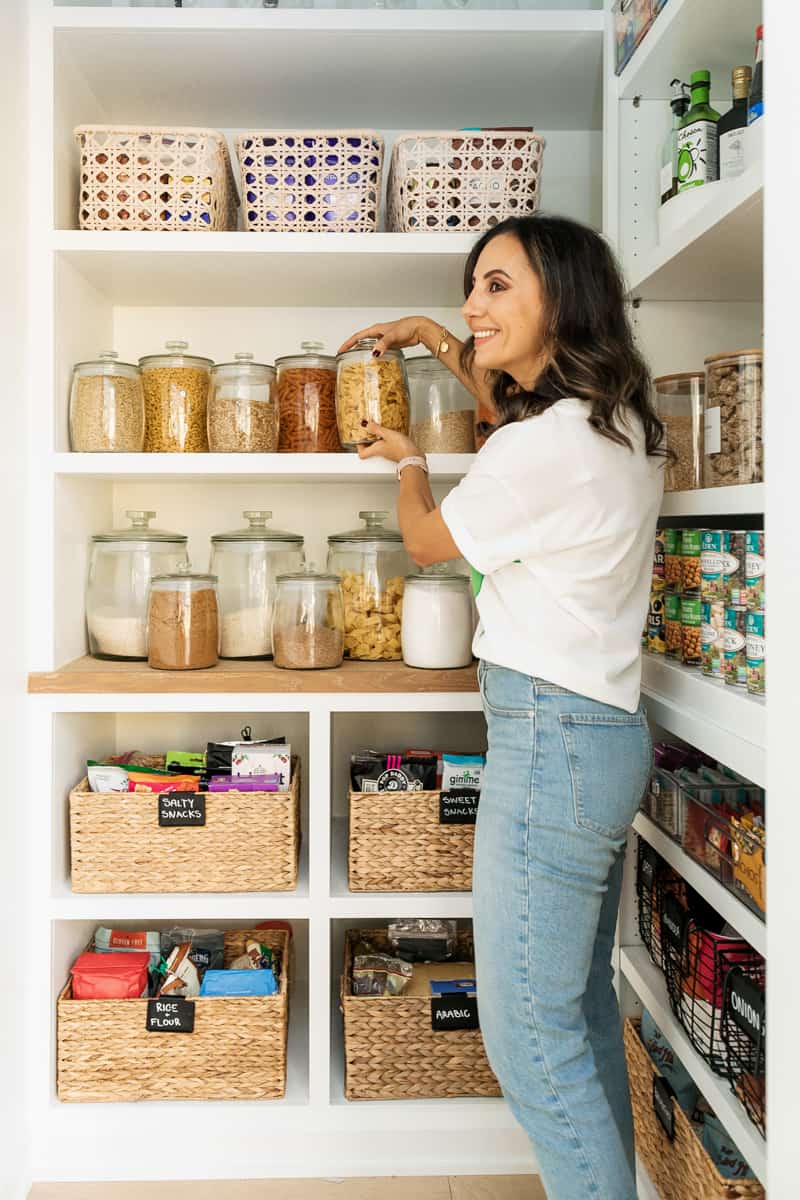
Being in the business of food, I always have a well-stocked pantry, and below you’ll see an example of what I mean by a well-stocked pantry. While I buy specialty items here and there for recipe testing and offering variety to my family, I love keeping the below pantry staples stocked at all times. It gives me the peace of mind that I can whip up breakfast, lunch, dinner, or even dessert without having to run to the store.
Tips for How to Stock Your Pantry
Before diving into the categories and list of items, here are some things to keep in mind as you’re stocking your pantry.
- Buy most frequently used items in bulk. If your kids eat peanut butter and jelly sandwiches every day or you make spaghetti once a week, always keep two jars of peanut butter and several packages of pasta on hand. They won’t go to waste.
- Keep a running list and check before you go to the store. Nothing spoils dinner plans like reaching for the EVOO to saute onions and finding half an inch left in the bottle. When the bottle is half empty, buy another. Treat your kitchen like a factory. Stock the parts.
- Organize in zones. Use certain shelves and sections for grains and pastas, while keeping sweet and salty snacks in a different section that may be easier to reach for the family. Baskets are also helpful for this so that you can label one for miscellaneous dinner foods (like taco shells and rice paper) and another one for rice and flour.
- Think about versatility. A big container of old-fashioned oats can make Overnight Oats for breakfast, Oatmeal Cookies for the class party and topping for a Mixed Berry Crisp. Walnuts go into brownies one night and add protein to a salad the next night.
- Bring the flavor. Use store-bought condiments to spice up the everyday. Mix mayo and sriracha for a spicy topping for chicken or fish, a spoonful of sun-dried tomatoes with one pan pasta makes it seem like it’s from your favorite Italian restaurant. Specialty oils, like toasted sunflower oil, can lend a nutty surprise to basic vinaigrettes.
- Recycle to organize. A shelf of matching clear containers and baskets is fabulous, but mason jars or recycled glass containers like old pickle or jam jars are perfect for storing odds and ends. I think jars are visually more pleasing than a bunch of half-filled bags and they will also keep pantry pests out. A tip from professional kitchens: label everything including its expiration date.
Categorized Pantry List
Click on this link (How to Stock A Pantry) to print the below PDF check list. And below you can find more information about each category and some extra things to keep in mind when stocking some of these categories.
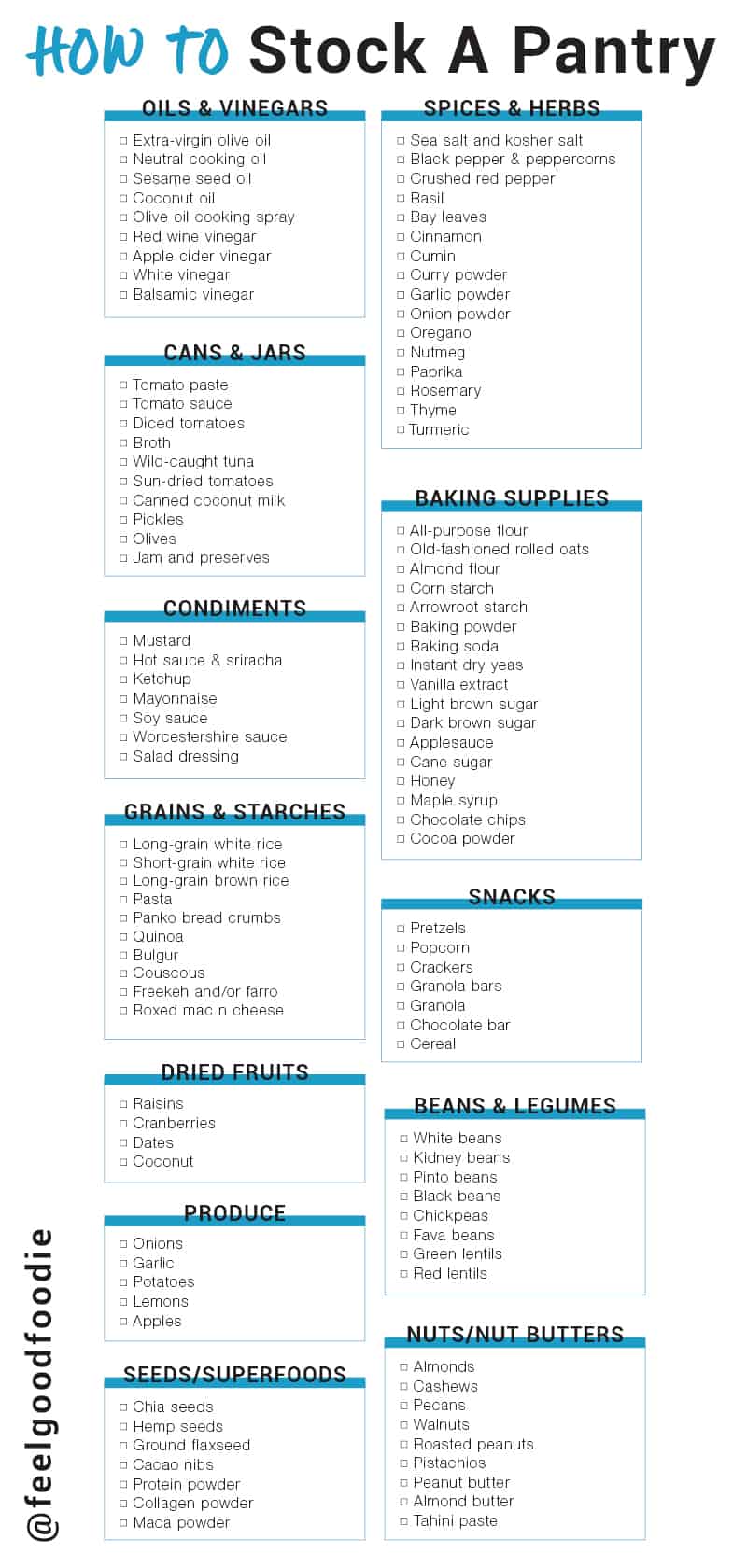
Grains and starches
Dress them up or dress them down. These pantry meal heroes combine long shelf life with unlimited versatility. These are the ones I often use in my Mediterranean dishes and overall healthy recipes. Make sure to add the ones your family loves.
- Long-grain white rice
- Short-grain white rice
- Long-grain brown rice
- Pasta (spaghetti, penne, elbow, orzo, lasagne sheets)
- Panko breadcrumbs
- Quinoa
- Bulgur
- Couscous
- Freekeh and/or farro
- Boxed Mac n cheese
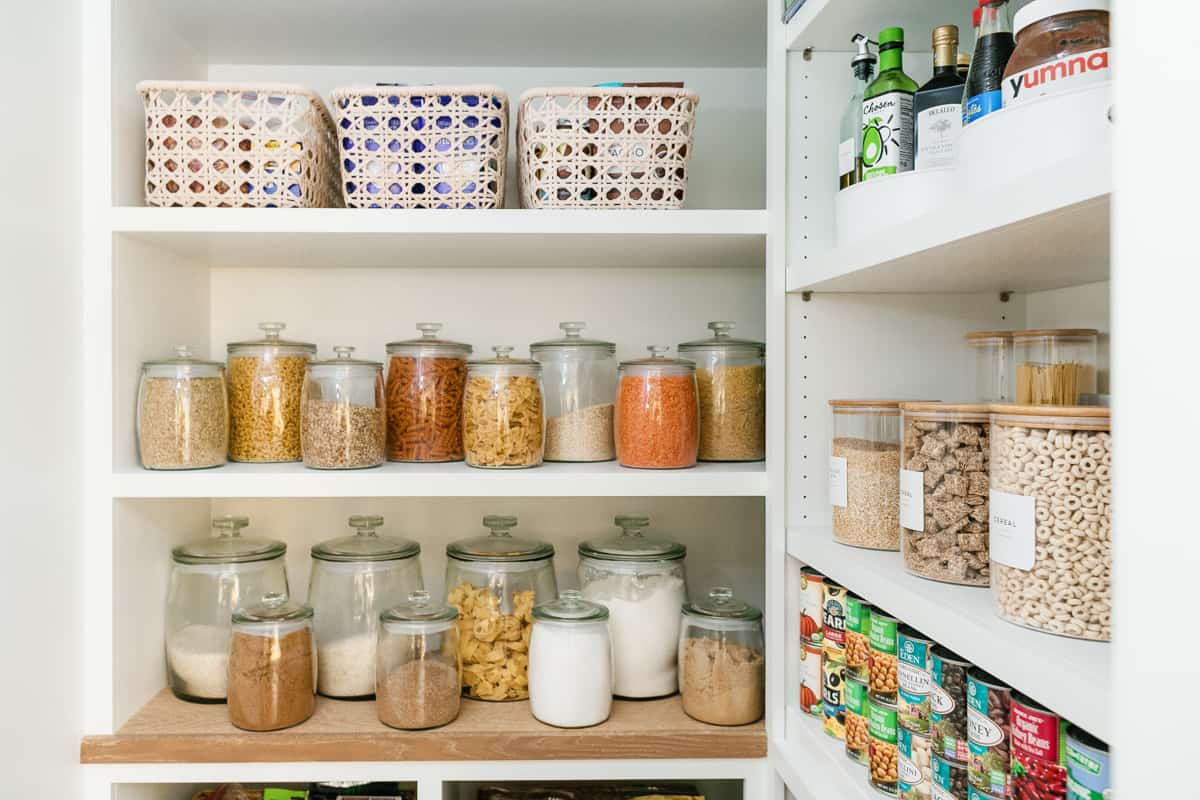
Condiment, Oils and Vinegars
Olive oil is my favorite oil to have on hand for all kinds of meals. It’s versatile to be used for cooking or drizzled fresh on salads, hard boiled eggs or my labneh yogurt. It’s also a great idea to have some neutral oils for sautéing along with vinegars for salads and adding acidity to some cooked dishes.
- Extra-virgin olive oil
- Avocado oil
- Sesame seed oil
- Coconut oil
- Olive oil cooking spray
- Red-wine vinegar
- Apple cider vinegar
- White vinegar
- Balsamic vinegar
- Soy sauce
- Worcestershire sauce
- Hot sauce
- Honey
- Tahini paste
- Pomegranate molasses
- Rose water
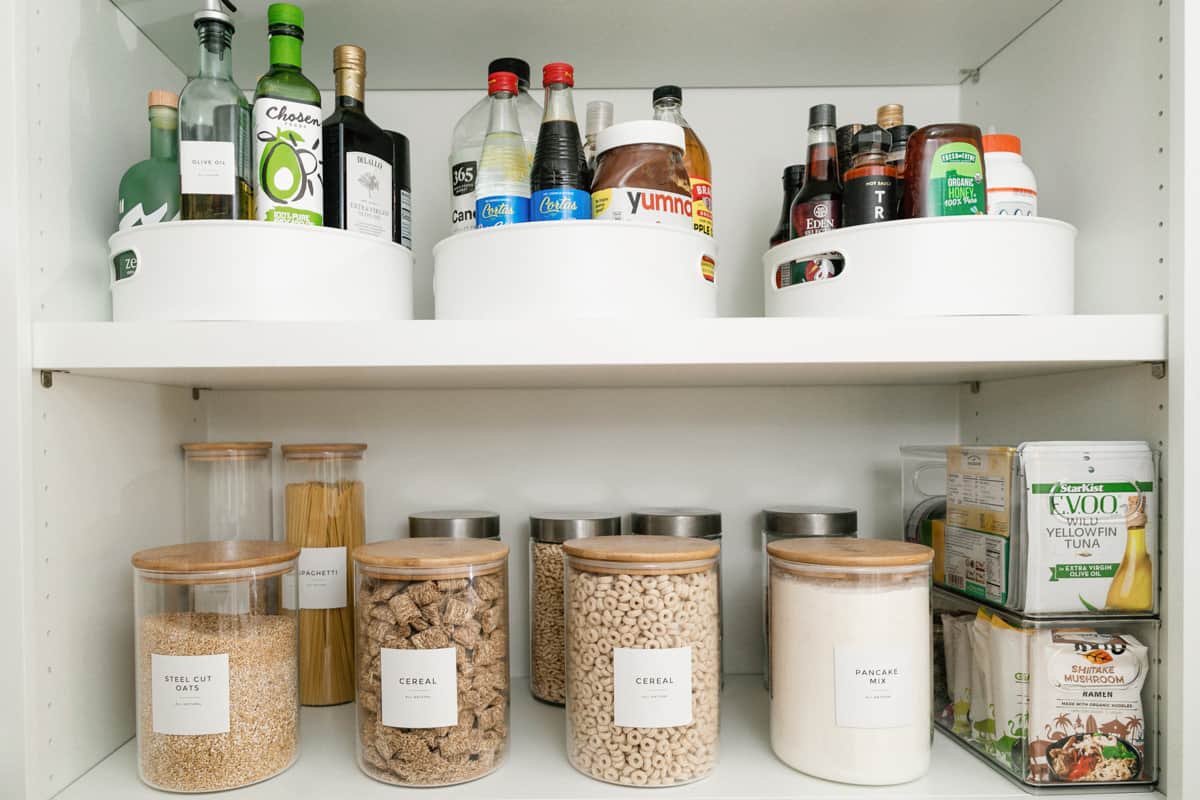
Cans and Jars
These are some of the longest shelf-life products you can keep in your pantry. So it doesn’t hurt to always have them on hand if you have the space. I prefer to buy my canned goods organic or at least ensure that they are BPA-free. When it comes to jams and jellies, look for ones that are just sugar and fruit or only fruit.
- Pumpkin puree
- Olives
- Diced tomatoes
- Whole tomatoes
- Tomato sauce
- Tomato paste
- Broth (vegetable or chicken in a carton)
- Wild-caught tuna (in water or olive oil in pouches)
- Sun-dried tomatoes
- Canned coconut milk

Spices and dried herbs
These are all the spices stocked in my pantry that you will see over and over again in my recipes. Every once in a while, it’s fun to get a new taco seasoning mix or fish rub, but I recommend buying small quantities of those until you know you love it. As a Middle Eastern blogger, some speciality spices I always have in my pantry also include 7 Spice, Cardamom, Coriander, Sumac and Za’atar.
- Sea salt and kosher salt
- Black pepper & peppercorns
- Crushed red pepper
- Basil
- Bay leaves
- Cinnamon
- Cumin
- Curry powder
- Garlic powder
- Onion powder
- Oregano
- Nutmeg
- Paprika
- Rosemary
- Thyme
- Turmeric
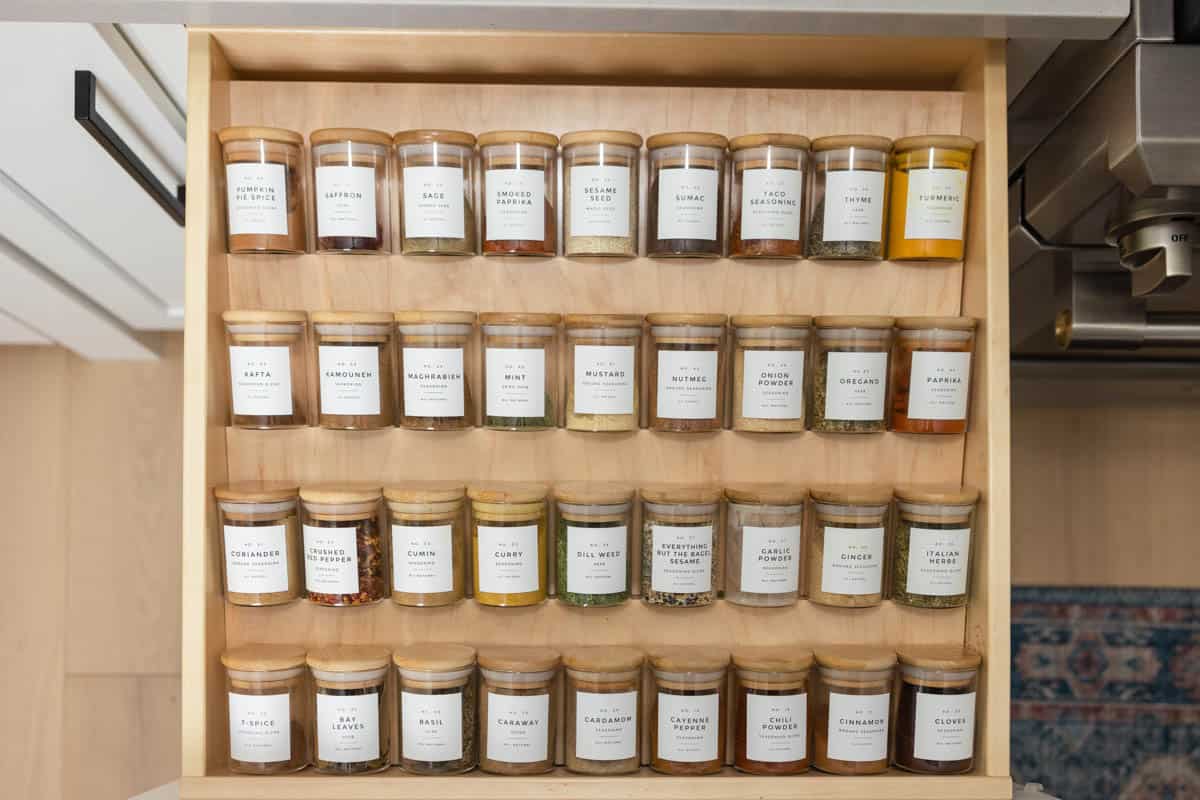
Beans and legumes
What is not to love about this fiber-filled, shelf-stable plant protein? Dried and canned both deserve some space on your shelf. Canned beans can last up to two years and some say dried beans have an indefinite lifespan – although cooking time may go up and flavor down after two years.
- White beans
- Kidney beans
- Pinto beans
- Black beans
- Chickpeas
- Fava beans
- Green lentils
- Red lentils
Nuts and nut butters
Nuts are great for healthy and satisfying snacking. Heart healthy nut butters go a long way in sandwiches or smoothies or on crackers.
- Almonds
- Cashews
- Pecans
- Walnuts
- Roasted peanuts
- Pistachios
- Peanut butter (creamy & crunchy)
- Almond butter
Dried fruits
Dried fruit sweetens baking projects and is great for snacking when fresh is not available. We especially love dates and they have such a long shelf life, which makes it great for long-term storing.
- Raisins
- Cranberries
- Dates
- Shredded coconut
Produce (shelf stable)
Properly stored, these essentials can last for weeks. Make sure they are all well ventilated in baskets or mesh bags so that they last longer.
- Onions
- Garlic
- Potatoes (Yukon Gold and sweet potatoes)
- Lemons
- Apples
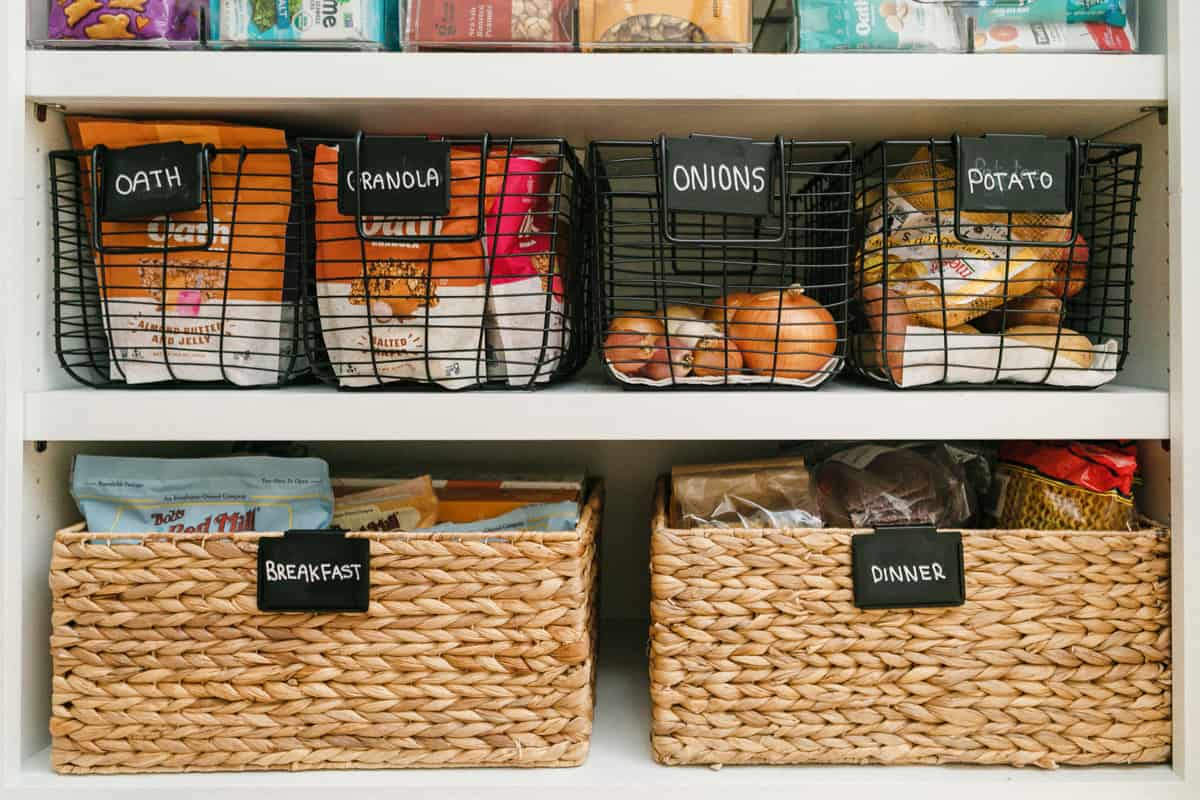
Baking supplies
With these ingredients, you can make any of my dessert recipes, including cookies, muffins and breads.
- All-purpose flour (white unbleached)
- Old fashioned rolled oats
- Almond flour
- Corn starch
- Baking powder
- Baking soda
- Instant dry yeast
- Vanilla extract
- Granulated sugar
- Light brown sugar
- Dark brown sugar
- Applesauce
- Maple syrup
- Chocolate chips
- Cocoa powder
Snacks
We try to change this up by adding something fun and new every time the kids go grocery shopping with me. But they can always rely on these essential snacks in the pantry.
- Pretzels
- Popcorn
- Crackers
- Granola bars
- Oat bars
- Granola
- Assorted nuts
- Seaweed crackers
- Chocolate
- Cereal (not exactly a snack)
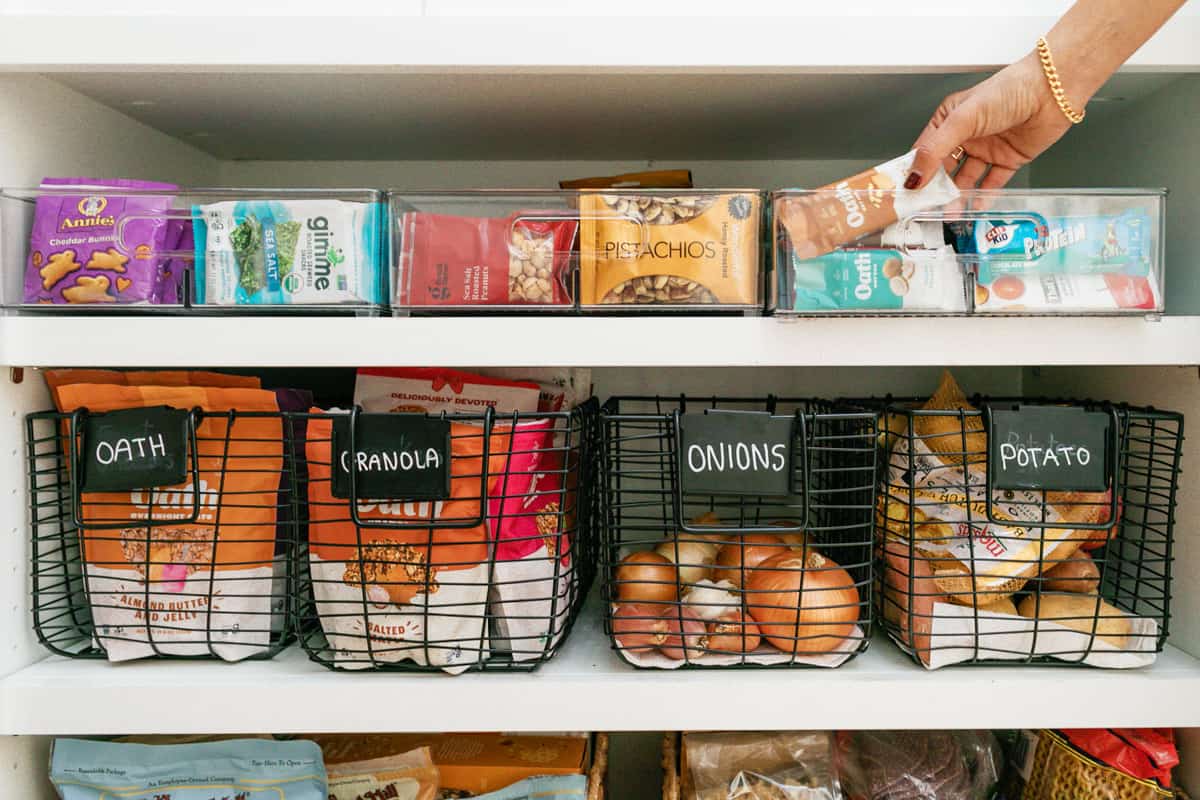
Seeds and superfoods
These add a nutritionally boast to loads of recipes, especially breakfast recipes and smoothies. It’s a great way to stay healthy when you may not have access to fresh fruits and vegetables.
- Chia seeds
- Hemp seeds
- Ground flaxseed
- Cacao nibs
- Protein powder
- Collagen powder
A well-stocked pantry is an investment that pays me back every day. I can throw together a quick dinner, mix up a simple salad dressing, or serve the kids an after-school snack without an inconvenient detour to the supermarket.
Stay tuned for next week when I share how to stock your your fridge.
Be sure to check out these helpful resources:
- How to Stock A Freezer
- School Lunchbox Ideas – even if you’re home!
- Daily Breakfast Ideas to Stay Healthy
- 16 Pantry Meal Ideas
- 15 Easy No Bake Desserts
- 10 Recipes with Vegetable Broth
If you find these tips for how to stock your pantry useful, I’d love to hear from you! And if you snapped some shots of your well-stocked pantry, share it with me on Instagram so I can repost on my stories!
This is first-rate! Just what I was looking for.
Happy this was helpful!
I keep a list on the inside pantry door, so I know what I have on hand @ all times. Thank for sharing. I haven’t found any of your recipes yet.
Wow, love this! Thanks for sharing!
First of all I love your name YUM na . It so fitting for you that you work with food and you love sharing your recipes and ideas. Thank you for this.
I love all of your ideas and I just printed out your PANTRY LIST to share with my 21 year old niece that will be graduating this year !! She loves cooking so this will come in handy for her as well as all the Kitchen supplies Grammie (me) and she has been busy collecting,
Thanks again Yumna for the great RECIPES and Ideas.
Rhoni Pesch
Thank you so much, Rhoni! I am so glad that you found the pantry list helpful, and I appreciate you sharing it!